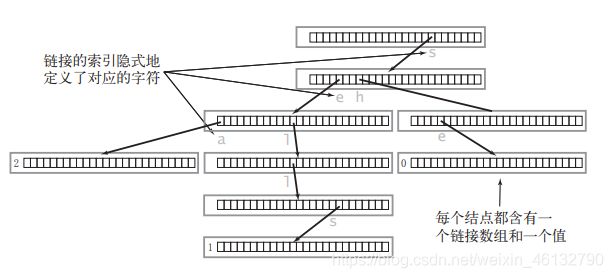Leetcode208. 实现Trie(前缀树)C++实现
Leetcode208. 实现Trie(前缀树)
一. 前缀树介绍
1、应用
Trie (发音为 “try”) 或前缀树是一种树数据结构,用于检索字符串数据集中的键。这一高效的数据结构有多种应用:
1)自动补全

2)拼写检查

3)IP路由(最长前缀匹配)

4)九宫格打字预测

5)单词游戏

2、优势
还有其他的数据结构,如平衡树和哈希表,使我们能够在字符串数据集中搜索单词。为什么我们还需要 Trie 树呢?尽管哈希表可以在 O(1)时间内寻找键值,却无法高效的完成以下操作:
找到具有同一前缀的全部键值。
按词典序枚举字符串的数据集。
Trie 树优于哈希表的另一个理由是,随着哈希表大小增加,会出现大量的冲突,时间复杂度可能增加到 O(n),其中 n 是插入的键的数量。与哈希表相比,Trie 树在存储多个具有相同前缀的键时可以使用较少的空间。此时 Trie 树只需要 O(m) 的时间复杂度,其中 m 为键长。而在平衡树中查找键值需要 O(mlogn) 时间复杂度。
二. Trie树节点结构介绍
Trie 是一颗非典型的多叉树模型,多叉好理解,即每个结点的分支数量可能为多个,其结点具有以下字段:
1)最多 R 个指向子结点的链接,其中每个链接对应字母表数据集中的一个字母。
本文中假定 R 为 26,小写拉丁字母的数量。
2)布尔字段,以指定节点是对应键的结尾还是只是键前缀。、

C++实现:
struct TrieNode {
bool isEnd; //该结点是否是一个串的结束
TrieNode* next[26]; //字母映射表
};
这时字母映射表next 的妙用就体现了,TrieNode* next[26]中保存了对当前结点而言下一个可能出现的所有字符的链接,因此我们可以通过一个父结点来预知它所有子结点的值:
for (int i = 0; i < 26; i++) {
char ch = 'a' + i;
if (parentNode->next[i] == NULL) {
说明父结点的后一个字母不可为 ch
} else {
说明父结点的后一个字母可以是 ch
}
}
示例:包含三个单词"sea",“sells”,"she"的 Trie 树

Trie 中一般都含有大量的空链接,因此在绘制一棵单词查找树时一般会忽略空链接,同时为了方便理解我们可以画成这样:
三、Trie树常见操作
3.1 插入
描述:向 Trie 中插入一个单词 word
实现:这个操作和构建链表很像。首先从根结点的子结点开始与 word 第一个字符进行匹配,一直匹配到前缀链上没有对应的字符,这时开始不断开辟新的结点,直到插入完 word 的最后一个字符,同时还要将最后一个结点isEnd = true;,表示它是一个单词的末尾。
/** Inserts a word into the trie. */
void insert(string word) {
Trie* node = this;
for(char c : word){
if(node->next[c-'a']==nullptr)node->next[c-'a'] = new Trie();
node = node->next[c-'a'];
}
node->isEnd = true;
}
3.2 搜索键
描述:查找 Trie 中是否存在单词 word
实现:从根结点的子结点开始,一直向下匹配即可,如果出现结点值为空就返回false,如果匹配到了最后一个字符,那我们只需判断node->isEnd即可。
/** Returns if the word is in the trie. */
bool search(string word) {
Trie* node = this;
for(char c : word){
if(node->next[c-'a']==nullptr)return false;
node = node->next[c-'a'];
}
return node->isEnd;
}
3.3 前缀查找
描述:判断 Trie 中是或有以 prefix 为前缀的单词
实现:和 search 操作类似,只是不需要判断最后一个字符结点的isEnd,因为既然能匹配到最后一个字符,那后面一定有单词是以它为前缀的。
/** Returns if there is any word in the trie that starts with the given prefix. */
bool startsWith(string prefix) {
Trie* node = this;
for(char c : prefix){
if(node->next[c-'a']==nullptr) return false;
node = node->next[c-'a'];
}
return true;
}
四、总结
通过以上介绍和代码实现我们可以总结出 Trie 的几点性质:
1、Trie 的形状和单词的插入或删除顺序无关,也就是说对于任意给定的一组单词,Trie 的形状都是唯一的。
2、查找或插入一个长度为 L 的单词,访问 next 数组的次数最多为 L+1,和 Trie 中包含多少个单词无关。
3、Trie 的每个结点中都保留着一个字母表,这是很耗费空间的。如果 Trie 的高度为 n,字母表的大小为 m,最坏的情况是 Trie 中还不存在前缀相同的单词,那空间复杂度就为 O(m^n)。
最后,关于 Trie 希望你能记住 8 个字:一次建树,多次查询。
五、全部代码
class Trie {
private:
bool isEnd;
Trie* next[26];
public:
/** Initialize your data structure here. */
Trie() {
isEnd = false;
memset(next, 0, sizeof(next));
}
/** Inserts a word into the trie. */
void insert(string word) {
Trie* node = this;
for(char c : word){
if(node->next[c-'a']==nullptr)node->next[c-'a'] = new Trie();
node = node->next[c-'a'];
}
node->isEnd = true;
}
/** Returns if the word is in the trie. */
bool search(string word) {
Trie* node = this;
for(char c : word){
if(node->next[c-'a']==nullptr)return false;
node = node->next[c-'a'];
}
return node->isEnd;
}
/** Returns if there is any word in the trie that starts with the given prefix. */
bool startsWith(string prefix) {
Trie* node = this;
for(char c : prefix){
if(node->next[c-'a']==nullptr) return false;
node = node->next[c-'a'];
}
return true;
}
};
/**
* Your Trie object will be instantiated and called as such:
* Trie* obj = new Trie();
* obj->insert(word);
* bool param_2 = obj->search(word);
* bool param_3 = obj->startsWith(prefix);
*/
参考链接:
1、https://leetcode-cn.com/problems/implement-trie-prefix-tree/solution/shi-xian-trie-qian-zhui-shu-by-leetcode/
2、https://leetcode-cn.com/problems/implement-trie-prefix-tree/solution/trie-tree-de-shi-xian-gua-he-chu-xue-zhe-by-xiao-x/
若有侵权,联系删帖~
